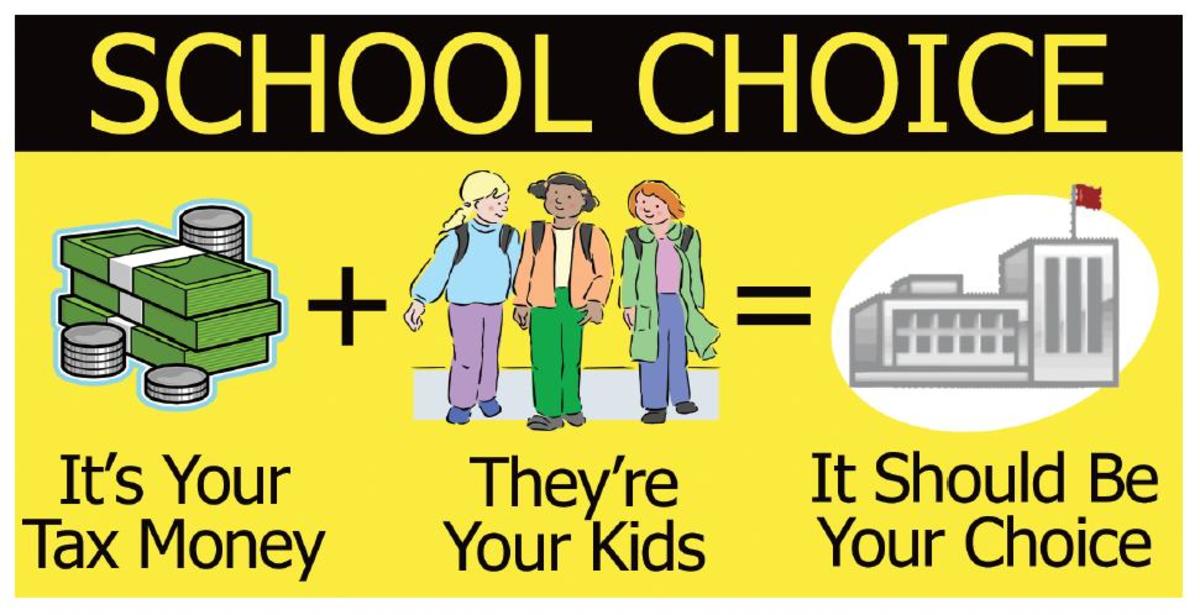Training Your Shadow Part II: Choice Without Competition?

School Vouchers in Douglas County, CO
“ . . . as the world economy demands more nonroutine, creative, conceptual abilities—too many schools are moving in the wrong direction. They’re redoubling their emphasis on routines, right answers, and standardization. And they’re hauling out a wagon full of ‘if-then’ rewards—pizza for reading books, iPods for showing up to class, cash for good test scores. We’re bribing students into compliance instead of challenging them into engagement.” ---Daniel Pink (2009, p.174)
Last week, Douglas County School District in Colorado approved a pilot program that would give 500 students vouchers to attend private schools of their choice. While the idea of choice is admirable, the primary motive behind the voucher push boils once again down to saving money. The district stands to save close to $400,000. When asked what made board members decide to okay the voucher program instead of pointing to the cost-effectiveness, many echoed what board member, Doug Benevento had to say: “Families deciding what's best for them. It's the best choice. It's the only choice." It’s hard to argue with pathos appeals. The idea of choice is a time-honored value in American culture. What concerns me more than the fact that this appears to be a business decision, is that many purport the natural consequence of introducing vouchers is that schools will compete for students, and therefore all schools in the district will get better
However, each student will only be eligible to receive $4,575 which is not much considering most private schools have annual tuitions of between $14, 000-$21,000 (2009-2010 National Association of Independent Schools reported an average $19, 906 for private day school tuition). Karen Auge of The Denver Post reports that in a survey The Post conducted of the county “some [private schools in the district] are as low as $4,695 a year and others as high as $21,000” (“Dougco”). The county’s median household income as of 2008, according to the US Census Bureau, was $100, 493. The county has very little ethnic or socio-economic diversity.
The real result of this particular voucher program is that only those middle class families who were already considering tightening their belts a little more to send their children to private school will be able to take advantage of the voucher. Those who cannot afford the added expense, will still not be moved because the voucher takes only a small bite out of most of the tuition costs reported from private schools in the area.
Most articles and editorials reporting on this move by the district end with “we’ll be watching to see how successful it is,” . . . “a model for other districts” . . . . The voucher pilot program may work just fine in Douglas County, but it should not be the model for other districts considering such a move for two reasons—first, districts with high socio-economic diversity will be affected dramatically differently and second, a business model of competition should never be considered when it comes to public education.
More Segregation
Let’s consider the first point. One editorial out of the Colorado Springs Gazette had this headline attached to the story: “Vouchers will end an era of bigotry.” The editorial board is referring to Colorado’s Blaine Amendment which prohibits state funds from being used for religious education. The Gazette editorial board believes the Blaine Amendment stems from “anti-immigrant, anti-catholic, anti-Irish bigotry that was rampart in this country in the late 19th and early 20th centuries.” The voucher program cannot end bigotry—only confound it.
While it may allow religious middle-to-upper-middle class families to choose religious schools of their choice for their children without breaking their banks, this will not be the norm. Instead, it will only aggravate what scholars like Jonathan Kozol (2005) have been telling us about the alarming lack of diversity in public schools. In Shame of a Nation: The Restoration of Apartheid Schooling in America, Kozol reports:
"In suburban Roosevelt on Long Island, as a consequence [of self segregation phenomenon], nearly 100 percent of students at the high school are black or Hispanic. A twenty-minute drive away, at Plainview High, black and Hispanic students make up only 1 percent of the enrollment while 97 percent of students at the school are white. In numerous other districts in the areas surrounding New York City, black and Hispanic children go to public schools in which they find themselves as isolated as are children of color in the Bronx." (Kindle locations 471-76)
Some will argue that vouchers will help stop this phenomenon, but it will necessarily do the reverse. The reality is that most of those in the lowest socio-economic brackets still tend to be Americans of color. While it will help middle-to-upper-middle class families of any race finally make the switch if they have already been contemplating it for their children, it will most likely be the least culturally or socio-economically-diverse group of families who do so.
Those left behind at the “regular” school will be adversely affected by the increased lack of diversity. Again, consider what Kozol (who has been fighting for equality in public schooling all of his professional life) has to say when referring to Brown vs. Board of Education (1954):
"To separate black children from white children of their age and qualifications on the basis of their race, the court went on “generates a feeling of inferiority as to their status in the community that may affect their hearts and minds in a way unlikely ever to be undone . . . . In the field of public education, the doctrine of ‘separate but equal’ has no place."
In 1954, it was mostly a concern about racial diversity. Today, we have to consider socio-economic diversity as well as cultural and ethnic diversity. The continued growth of separate enclaves of society of the same socio-economic bracket, mostly of the same cultural background, with mostly the same religious ideas is irresponsible—and even, I’d argue, sociologically dangerous. American leaders tell us they want our nation to be globally competitive. How can we honor and collaborate with people of other countries when we purposefully avoid doing so in our own country? Why are we more accepting of someone from Japan, China, or India than we are of our own melting pot of citizenry?
Education Is Not a Business
The Denver Post editorial board also chimed in on the discussion of Douglas County’s decision saying, “Ideally, giving parents a choice of where they can send their children to school will create healthy competition for traditional public schools in the district.” There is no such thing as “healthy competition” when it comes to schooling. Schools are already competing—and they shouldn’t be. Not in a business model approach. Remember the opening quote by Daniel Pink? “iPods for showing up to class?” People may dismiss this as nonsense, but it’s reality. What “healthy competition” has done to schools is create nothing more than elaborate systems of bribery. Money that could be spent on a stack of new books for the library is being spent on buying iPods so schools can hold raffles on Count Day. Money is the driving force.
What is public education? Is it not the education of America’s public? Is not all of America’s public equally worthy? Why would we want one school to out-do another? Wouldn’t the kids of the outdone school suffer? “No, no,” opponents will retort, “it’s not that we want one school to out-do another, it’s just that if they compete, they all get better. Teachers do a better job. All kids benefit.”
When “success” is rewarded fiscally, all schools suffer. The schools that are already struggling receive probationary funding, yet they are asked to “turn things around.” Whose kids are going to those schools? Property taxes greatly influence the amount of funding schools receive. While all schools receive a per pupil stipend from the state, voters in school districts help determine additional funding. Schools located in wealthier areas receive greater proportions of property taxes. If you are a principal of a poorly funded school, are you going to be giving out iPods on count day? Pizza for classes reaching their Accelerated Reading goals? Is this really what is meant by “teachers will do a better job?”
Some will point to choice and link it to our ideals about liberal democracy. Choice is always seen as good. However, as Fareed Zaharia (2003), points out, “There can be such a thing as too much democracy—too much of an emphatically good thing . . . . Democracy is also a single ideology, and, like all such templates, it has its limits. What works in a legislature might not work in a corporation” (p.337). And, I’d further argue, what works in a corporation might not work in a system of public service like education.
America’s public education system is a complicated mess. If we heed Pink’s analysis of the cultural change of business, however, we can give ourselves a healthy boost in a new direction. For those who still emphatically argue that a business model can be applied to education and reap similar rewards, what if Pink is correct in his estimation that business itself is changing—that an if-then rewards system will no longer be the norm? What if he’s right and “a newfangled emphasis on self-direction” is in order? Consider it in his own words:
"I’ve seen the future—and it works. It works in around-the-clock bursts in Sydney, Australia. It works on guerilla-style side projects in Mountain View, California. And it works whenever it damn well pleases in Charlottesville, Virginia. The reason why it works is because of how it works. On the edges of the economy—slowly, but inexorably—old-fashioned ideas of management are giving way to a newfangled emphasis on self-direction." (Pink, 2009, p.86)
The introduction of vouchers, masquerading as a triumph of enhanced choice, will not radically change all schools in the Douglas County District. It will do even less in more diverse districts. And for some districts, it will have adverse effects on student populations.
If school administrators, if teachers for that matter, want to improve education and inspire our youth to be globally competitive, we need to enhance our approach to self-directed motivation. We need to stop bribing our kids. They truly deserve better.
References
Arugé, K. “Dougco school board Oks tuition voucher plan.” Denver Post. 15 Mar. 2011.Retrieved 20 Mar. 2011. Online.
“Editorial: School vouchers spell choice in Douglas County.” Denver Post. 18 Mar. 2011.Retrieved 20 Mar. 2011. Online.
Kozol, J. (2005). The Shame of the Nation: The Restoration of Apartheid Schooling in America.Kindle ed. Broadway Publishers.
“Our View: Vouchers will end an era of bigotry.” Gazette.com. The Gazette. 19 Mar. 2011.Retrieved 20 Mar. 2011. Online.
National Association of Independent Schools. (2000-2010). “Facts at a Glance.” Online.
Pink, D.H. (2009). Drive: The Surprising Truth About What Motivates Us. New York: Riverhead Books.
Zakaria, F. (2003). “The Democratic Age.” In Ideas Across Time: Classic and Contemporary Readings for Composition. Igor Webb. (Ed). Boston: McGraw Hill.
Brief Bio:
Jenn Gutiérrez holds an M.F.A in English and Writing. Previous work has appeared in journals such as The Texas Review, The Writer’s Journal, The Acentos Review, Antique Children, and Verdad Magazine. Her 2005 debut collection of poems titled Weightless is available through most online book outlets.









